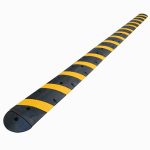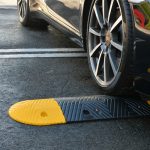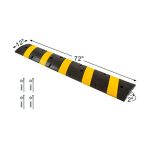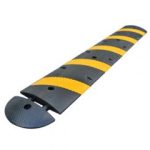Speed bumps and humps are traffic calming devices that are used to reduce vehicle speed in certain areas. They are typically raised sections of road that force drivers to slow down as they pass over them. The main purpose of speed bumps and humps is to improve safety by preventing accidents and reducing the risk of pedestrian injuries. These devices are commonly found in residential areas, school zones, and parking lots, where speed limits need to be enforced. Speed bumps are usually shorter and wider, while speed humps are longer and narrower. Both types of devices serve the same purpose, but they have slightly different designs and effects on vehicle speed. Overall, speed bumps and humps play an important role in promoting road safety and creating a more pedestrian-friendly environment.
Importance of speed bumps and humps
Speed bumps and humps play a crucial role in ensuring road safety and traffic control. These traffic calming devices are strategically placed on roads to slow down vehicles and reduce the risk of accidents. The importance of speed bumps and humps cannot be overstated, as they effectively force drivers to reduce their speed, especially in areas where pedestrians and cyclists are present. By maintaining a controlled speed, these devices help create a safer environment for everyone on the road, including motorists, pedestrians, and cyclists. Additionally, speed bumps and humps also serve as a visual reminder for drivers to be cautious and attentive while driving, ultimately contributing to a decrease in the number of road accidents. Therefore, it is essential for cities and communities to invest in the installation and maintenance of speed bumps and humps to ensure the safety and well-being of all road users.
Traditional Speed Bumps
Design and construction
Design and construction are crucial aspects when it comes to speed bumps and humps. The design of these traffic calming devices must take into consideration various factors such as the road conditions, the desired speed reduction, and the impact on vehicle suspension. Additionally, the construction of speed bumps and humps should be done using durable materials that can withstand heavy traffic and adverse weather conditions. Proper installation techniques and adherence to safety standards are also essential to ensure the effectiveness and longevity of these traffic control measures. Overall, a well-designed and properly constructed speed bump or hump can effectively slow down vehicles and enhance road safety.
Advantages and disadvantages
Advantages and disadvantages of speed bumps and humps vary depending on the context and perspective. On one hand, these traffic calming measures can effectively reduce vehicle speeds, making roads safer for pedestrians and cyclists. They can also help to control traffic flow and discourage reckless driving. However, speed bumps and humps can be a nuisance for drivers, causing discomfort and potential damage to vehicles if not properly designed and maintained. Additionally, they may lead to increased noise pollution and emissions due to frequent acceleration and deceleration. Overall, the benefits and drawbacks of speed bumps and humps should be carefully considered before implementing them in any given area.
Effectiveness in reducing speed
Speed bumps and humps are highly effective in reducing speed and promoting safer driving. These traffic calming measures are designed to slow down vehicles, particularly in areas where speeding is a concern. By forcing drivers to slow down, speed bumps and humps help prevent accidents and improve road safety. They are especially effective in residential areas, school zones, and areas with high pedestrian traffic. The presence of speed bumps and humps serves as a visual reminder for drivers to adhere to the speed limit, reducing the risk of collisions and creating a safer environment for everyone on the road.
Speed Humps
Difference from speed bumps
Speed humps and speed bumps are two common traffic calming devices used to reduce vehicle speeds in residential areas. While they may seem similar, there are some key differences between the two. Speed bumps are typically taller and narrower than speed humps, creating a more abrupt change in vehicle speed. They are often used in parking lots or areas where a significant reduction in speed is required. On the other hand, speed humps are wider and lower, allowing vehicles to maintain a higher speed while still encouraging them to slow down. They are commonly used on residential streets to create a gentle reminder for drivers to drive at a safe speed. Overall, the main difference between speed bumps and speed humps lies in their design and intended purpose, with speed bumps providing a more drastic speed reduction and speed humps offering a more gradual approach to traffic calming.
Design and installation
Design and installation are crucial aspects when it comes to speed bumps and humps. The design of these traffic calming measures should consider factors such as the speed limit of the road, the volume of traffic, and the type of vehicles that use the road. The installation process should be carried out by professionals to ensure that the speed bumps and humps are placed at the appropriate locations and meet the required specifications. Proper design and installation of speed bumps and humps can effectively reduce the speed of vehicles, improving safety for both pedestrians and drivers.
Benefits and drawbacks
Speed bumps and humps have both benefits and drawbacks. One of the main benefits is that they help to slow down vehicles, reducing the risk of accidents and promoting safer driving. They are particularly effective in residential areas and near schools, where pedestrian safety is a top priority. Additionally, speed bumps and humps can help to control traffic flow and discourage speeding, creating a more peaceful and quiet environment for residents. However, there are also some drawbacks to consider. Speed bumps and humps can cause discomfort and inconvenience for drivers, especially if they are not well-maintained or if they are installed in excessive numbers. They can also increase fuel consumption and emissions due to the need for frequent acceleration and deceleration. Overall, while speed bumps and humps have their advantages in terms of safety and traffic control, careful consideration should be given to their placement and design to minimize any negative impacts.
Speed Cushions
Unique features and design
Speed bumps and humps come in various designs and sizes, each with their own unique features. Some speed bumps are made of rubber or plastic, while others are constructed using asphalt or concrete. The design of speed bumps can also vary, with some being flat-topped and others having a rounded shape. Additionally, speed bumps may have reflective markings or be painted in bright colors to enhance visibility. The choice of speed bump design depends on factors such as the desired speed reduction, traffic volume, and the type of vehicles using the road. Overall, the unique features and design of speed bumps play a crucial role in effectively slowing down vehicles and ensuring road safety.
Advantages over traditional speed bumps
Advantages over traditional speed bumps include a smoother and more comfortable ride for drivers and passengers. Unlike traditional speed bumps that can cause jolts and discomfort, the different types of speed bumps and humps offer a gentler approach to reducing speed. Additionally, these innovative designs minimize the risk of damage to vehicles, as they are designed to be more forgiving and less likely to cause damage to the undercarriage. Furthermore, the various types of speed bumps and humps are visually appealing and can be customized to blend in with the surrounding environment, making them a more aesthetically pleasing option. Overall, these advantages make the different types of speed bumps and humps a preferable alternative to traditional speed bumps.
Considerations for installation
When considering the installation of speed bumps and humps, several factors need to be taken into account. Firstly, the purpose of the traffic calming measure should be considered. Are you aiming to reduce speed, improve safety, or both? This will help determine the type and design of speed bumps or humps that are most suitable for the specific location. Additionally, the volume and type of traffic should be considered. High-traffic areas may require more robust and durable speed bumps, while low-traffic areas may only need smaller, less intrusive humps. Finally, the impact on emergency vehicles and public transportation should be evaluated. It is important to ensure that speed bumps and humps do not hinder the response time of emergency vehicles or cause inconvenience to public transportation. By carefully considering these factors, the installation of speed bumps and humps can effectively contribute to creating safer and more controlled road environments.
Rubber Speed Bumps
Material and construction
Material and construction play a crucial role in the effectiveness and durability of speed bumps and humps. There are various materials used in their construction, including rubber, plastic, and asphalt. Rubber speed bumps are popular due to their durability and ability to withstand heavy traffic. Plastic speed bumps are lightweight and easy to install, making them suitable for temporary applications. Asphalt speed humps are commonly used on roads and highways as they provide a smoother ride for vehicles. The construction of speed bumps and humps involves careful planning and installation to ensure proper functionality and safety.
Benefits and drawbacks
Speed bumps and humps have both benefits and drawbacks. On the positive side, they are effective in reducing vehicle speeds, which can help improve safety in residential areas and school zones. They also serve as a visual and physical reminder for drivers to slow down and be cautious. Additionally, speed bumps and humps can help to calm traffic and discourage reckless driving. However, there are also some drawbacks to consider. For instance, they can cause discomfort and inconvenience for drivers and passengers, especially if they are not properly designed or maintained. They may also lead to increased noise and vibration for nearby residents. Furthermore, speed bumps and humps can potentially damage vehicles if drivers do not slow down sufficiently. Overall, while speed bumps and humps can be beneficial in certain situations, it is important to carefully consider their placement and design to ensure they are effective and do not create unnecessary problems.
Suitability for different environments
Speed bumps and humps come in various types, each designed to suit different environments. For residential areas with low traffic volume, small speed bumps are often used to slow down vehicles and ensure the safety of pedestrians. In contrast, larger speed humps are more suitable for high-traffic areas such as commercial zones or school zones, where vehicles need to slow down but not come to a complete stop. Additionally, rubber speed bumps are commonly used in areas with heavy snowfall or ice, as they are less likely to damage vehicles or cause accidents. Overall, the suitability of speed bumps and humps depends on the specific environment and the intended purpose of traffic management.
Virtual Speed Bumps
Technology behind virtual speed bumps
Virtual speed bumps are a modern technological innovation that aims to enhance road safety. Unlike traditional physical speed bumps, which are constructed on the road surface, virtual speed bumps utilize advanced technology to create the illusion of a speed bump without the need for any physical structures. These virtual speed bumps can be projected onto the road using lasers or other visual projection systems, giving drivers the perception of a physical obstacle that encourages them to slow down. This technology is particularly useful in areas where installing physical speed bumps may not be feasible or desirable, such as highways or busy urban roads. By effectively slowing down vehicles, virtual speed bumps contribute to reducing accidents, promoting safer driving habits, and improving overall road safety.
Advantages and limitations
Speed bumps and humps have several advantages and limitations. One of the main advantages is that they effectively reduce vehicle speeds, which can improve safety in areas with high pedestrian traffic or near schools and residential areas. Additionally, speed bumps and humps can help to calm traffic and discourage reckless driving. However, one limitation of speed bumps and humps is that they can cause discomfort and inconvenience for drivers, especially for those in emergency vehicles or with medical conditions. Furthermore, speed bumps and humps may increase noise pollution and vehicle emissions due to frequent acceleration and deceleration. Overall, while speed bumps and humps have their benefits in terms of traffic safety, it is important to consider their limitations and potential drawbacks when implementing them in road design.
Applications and future developments
Speed bumps and humps have a wide range of applications and there are ongoing developments to improve their effectiveness. One of the main applications of speed bumps and humps is in traffic calming measures, where they are used to reduce vehicle speeds and increase safety in residential areas, school zones, and parking lots. They are also used in traffic management to control the flow of vehicles and prevent excessive speeding. In addition, speed bumps and humps are increasingly being utilized in eco-friendly initiatives, such as reducing carbon emissions and promoting sustainable transportation options. As technology advances, there are future developments in speed bump and hump designs, including the use of smart sensors to detect approaching vehicles and adjust the height or firmness of the bump accordingly. These developments aim to enhance the effectiveness and efficiency of speed bumps and humps in improving road safety and creating more sustainable transportation systems.





